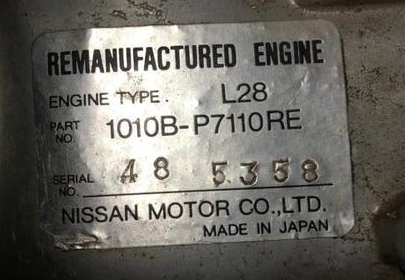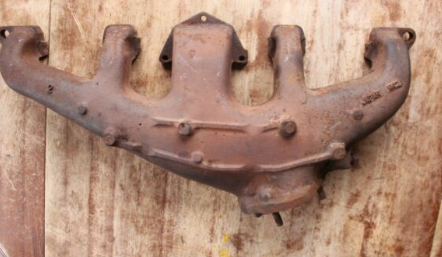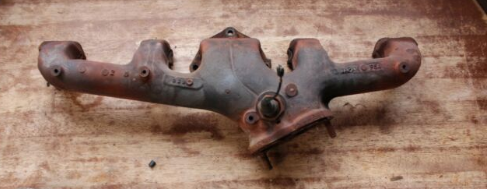Everything posted by Zed Head
-
"The Orange"
The tiniest scratch in the bore will leak. My car had a faint scratch from the wire spring that holds the dust seal in place. The PO must have let it slip and it scratched the bore. It worked fine but let a few drops of fluid leak after each drive. Took me a while to figure out why my tire had fresh liquid on it on a dry day. The PO also put the calipers on the wrong sides. He put the work in but just missed on the results.
-
Coil Pack Conversion - More Info Needed
You left out 280Z distributor + external ignition module. GM HEI, MSD, Crane, and other modules. Some of them are programmable. The 280Z distributor has the variable reluctor trigger, which is very solid and dependable.
-
240z engine/transmission swap
Looks like a Nissan reman. Rebuilt to Nissan specs. Should get 200,000 + miles from it. Do you know where it's been stored, and how? Does it have oil in it or is it empty? I would assume that Nissan coats the internals for rust prevention in preparation for shipping and storage, but who knows how long that lasts. Might be worthwhile to inspect rust prone surfaces before starting it. I don't know when Nissan stopped supplying reman engines but I'll bet it was over 20 years ago, at least. That engine has been floating around for that long. Fixed your picture -
-
What Electric Fuel Pump upgrade???
Most electric pumps come with a piece of rubber to wrap around the pump and isolate it from the body. How is yours mounted?
-
240z engine/transmission swap
Should be very easy. How about some pictures of the reman engine? We love to see other people's cool stuff. Is it in a box? Who reman'ed it? Nissan or someone else? Here are some images I stole from eBay. The ZX manifold is "shorter" and has a different angle to the flange. After 80 or 81, I think, they also had O2 sensors. https://www.ebay.com/i/383271658929?chn=ps&norover=1&mkevt=1&mkrid=711-117182-37290-0&mkcid=2&itemid=383271658929&targetid=541454198852&device=c&mktype=pla&googleloc=9033356&poi=&campaignid=6470549460&mkgroupid=81274343007&rlsatarget=pla-541454198852&abcId=1139336&merchantid=113625313&gclid=CjwKCAiAlO7uBRANEiwA_vXQ-1Ut8e94uWjLqn051V6ppSf1lEVw4fN47-rL18plbyR1TgFpPfq1RhoC-6gQAvD_BwE https://www.ebay.com/i/113846585162?chn=ps&norover=1&mkevt=1&mkrid=711-117182-37290-0&mkcid=2&itemid=113846585162&targetid=596465995348&device=c&mktype=pla&googleloc=9033356&poi=&campaignid=6470719577&mkgroupid=81597521270&rlsatarget=pla-596465995348&abcId=1140476&merchantid=113625313&gclid=CjwKCAiAlO7uBRANEiwA_vXQ-8FYIoFu21zAR6UlYdW4Q46ciHF9HVExnLM_lsVSp0AMijOc2agcsRoCBycQAvD_BwE
-
240z engine/transmission swap
The damper and pulleys should swap easily. No need to do so though. Since you're using carbs you don't need EFI hose. Just get some quality fuel line. You will probably need to do some exhaust system work, depending on where the L28 came from and how complete it is. The L24 manifold and down pipes might be smaller than L28 parts. 280ZX manifolds are different from 280Z manifolds. Basically though, the L28 and L24 engines are almost identical on the outside. Everything should swap over.
-
Failed CO emissions - all controls removed - where to start?
Here's another way that your timing could have retarded - you set the timing with the vacuum advance actuated, and the hose has fallen off. How did you set the initial timing and is the vacuum advance hose connected to the proper port on the TB?
-
fuel rail and pressure regulator suggestions-78 280Z
What's wrong? Not really clear what the problem is.
-
Failed CO emissions - all controls removed - where to start?
Sounds like something might have come loose in your distributor. You said "good", maybe there's a number associated? You measured a zero later. If timing went from good to zero then something has changed. Retarded timing will make the engine run like crap.
-
Separating front half of transmission case from adapter plate
They used to be available from Courtesy. Only one thickness though. You can stack the "ones" and get whatever thickness you need. http://www.carpartsmanual.com/datsun/Z-1969-1978/power-train/transmission-gears/5-speed/12 https://www.nissanpartsdeal.com/parts/nissan-shim-brg-0-1~32218-e9000.html
-
Separating front half of transmission case from adapter plate
Swap tap for pound...
-
fuel rail and pressure regulator suggestions-78 280Z
What is your new goal? Generally, for anyone with a 280Z, running through the electrical checks in the 1980 EFI Guide is recommended, along with verifying fuel pressure, and giving the engine a solid tuneup. Valve lash, timing, etc. Problems with the 280Z engines are usually a collection of small things, rarely just one big thing. Each correction of a small error closer to specification will make the engine run better.
-
Separating front half of transmission case from adapter plate
Can't remember for sure but I think that I found an edge on the adapter plate and used an aluminum rod to break it free from the front case. As you're finding there's not much to bang on otherwise. Somebody might have used a strong sealant on yours.
-
Failed CO emissions - all controls removed - where to start?
superlen makes a good point. The real issue might be that the engine is not getting to operating temperature. Or, maybe, the coolant level is low so the sensors are not reading actual engine temperature. Or, both sensors are fine but you have a flow issue in the thermostat housing. Anyway, temperature and the way the engine runs are your concerns. Plugs much darker than those have run fine in many of these engines. Check your cooling system closely, make sure coolant is flowing and the thermostat is actually closing, and that it's actually there. Many people have found that a PO removed their thermostat, trying to cure an overheating problem. The thermostat is actually a "heating" device, stopping coolant flow until the engine is warmed up.
-
Different ignition
With the unibodies sometimes the pieces you think are important aren't so much. Don't think that you need big solid frame rails for the car to be solid. The car is a steel box, with a few reinforcing pieces attached strategically. Many members here have cut away large sections of their cars to repair the rust.
-
fuel rail and pressure regulator suggestions-78 280Z
People have found leaking valve cover gaskets, Leaking injector seals. The BCDD is a possibility. It has a rubber diaphragm inside that can split. Vacuum leaks are a B.
-
fuel rail and pressure regulator suggestions-78 280Z
If you've run the idle speed screw all the way in and the engine still runs then you have a vacuum leak. Then engine can't run without air and that's what the idle speed screw controls. Check the PCV hose under the intake manifold. That's a possible air source. I don't recall seeing any pictures of your setup and whether it's stock or not. Wait...I went back and found your picture. Even the valve cover port is connected to the intake manifold through the PCV system. All of those holes have to be plugged. If that hole is still open put your thumb over it while the engine is running. Something will happen.
-
fuel rail and pressure regulator suggestions-78 280Z
Have you adjusted the idle speed screw? It's the screw with the big head and the spring underneath it on the throttle body. You can turn it by hand. When everything is right you can cause the engine to die by turning that screw all the way in.
-
Turbo vs Non-Turbo Camshafts - B vs F
Sorry, I might have assumed that they'd be there, separated. I don't have my FSM files handy, I've been on the road. My views on the things Nissan was doing in the late 70's and early 80's is that they were mostly about emissions. California smog was driving most of the development efforts in the automotive world. I traveled through LA in the early 80's and I seen what the problem was. LA was in a cloud, not a natural one.
-
Failed CO emissions - all controls removed - where to start?
Edit - responding to CO's post.... I can't tell what RPM that would be but I've wondered in the past about how much total advance might be seen under certain conditions. I had a distributor with "11" weights and a vacuum canister that gave 18, I think. So, 10 + 22 + 18 = 50 degrees. If I bumped my initial timing up to 14, I'd be at 54 degrees maximum. The centrifugal maxes out at about 2400 - 2500 RPM, commonly, so it's up there pretty quick. The vacuum curves are in the FSM. With your data you could probably put a map together, like the ones you use for programmable electronic control systems.
-
Failed CO emissions - all controls removed - where to start?
Very nice. But. I hate picking on people's hard word work, but the lowest RPM shown is 2300 RPM. Crack of the throttle should be down around 1000, I'd assume. As far as effect, the biggest might be that the timing advance to full vacuum advance setting. So timing probably jumps 18 degrees as soon as you crack the throttle.
-
Failed CO emissions - all controls removed - where to start?
Actually, you could describe the vacuum level on the port as matching manifold vacuum once the throttle blade opens. Zero when it's closed, manifold pressure (vacuum) once the blade moves. That's the simplest view. I think that Bernoulli, and Venturi's, principles have been discussed before as causing higher vacuum at the crack of the blade but I don't think that anyone has actually measured.it. So, really, it's just none and some.
-
Turbo vs Non-Turbo Camshafts - B vs F
You might double check the numbers using the FSM by year and model. They're in the Engine Mechanical chapter.
-
Spark plug reading
I was exaggerating with "wobble". It would have to be through the nose of the input shaft, which probably can't exert much force. The pilot bushing surface, the leverage point, is pretty small.
-
Failed CO emissions - all controls removed - where to start?
Yes, it goes to the distributor. Manuals and automatics both have vacuum advance timing also. The port on the throttle chamber is what they call "ported vacuum". It only has vacuum when the throttle is open, not at idle. The distributor's vacuum controlled timing advance and the carbon canister both use ported vacuum. Ported vacuum port on the throttle chamber goes to both the carbon canister and the distributor.









